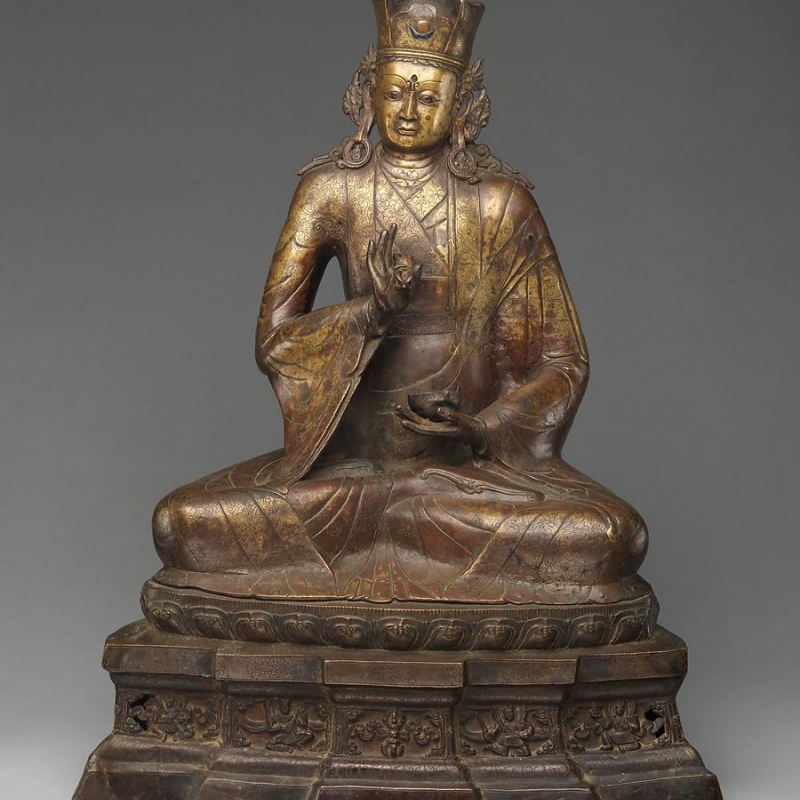Following is the transcript of a lecture by Professor Wangchuck Dorjee Negi, part of the Session IV 'Impact of Guru Padmasambhava in Our Time' from a two-day conference titled 'Conference on the Life and Legacy of Guru Padmasambhava'. This conference was held at the India International Centre, Delhi, in collaboration with Sahapedia and Centre for Escalation of Peace, January 29-30, 2019.
Tathagatha, the Buddha, mentioned three inconceivable powers: Inconceivable power of atoms, inconceivable power of karmic cause and result, and inconceivable power/potentiality of mind/citta. In the twenty-first century, we are aware of the power of atoms, for example, atomic bombs, supersonic jets, the internet, and so on. Regarding the karmic relation, with the help of modern science, we can see the wonder of the universe, the existence of various and diverse creatures living on the earth and in the sea. Thus, we can understand the inconceivable power of karmic cause and result. But today human beings are forgetting the power of the mind. Even though the mind is the very agent that causes all these other potentialities and various actions, modern science is not aware of it. Therefore, it is the need of the hour, and very much suitable time to discuss the great practitioner and accomplished master—Guru Padmasambhava. A person is not simply an aggregate of atoms and forms; it is the mind which is the dominant factor of a person. Unless we realise the existence and the infinite potentiality of mind, our life cannot experience genuine happiness.
The entire Buddhist literature talks about the nature of mind and the various techniques to discipline it. Therefore, the Buddha’s teachings are known as sasana, meaning training/discipline. Among these teachings, the Shravaka-vehicle emphasises on the elimination of attachment, hatred and lays more stress on the patimokkha samvara, the vow of self-liberation. Bodhisattva-vehicle or Paramita-vehicle considers compassion, etc., much more important than the patimokkha samvara or the elimination of attachment, hatred and so on. We find many sutras in which, sometimes, even some actions that are prohibited otherwise are allowed if it’s purely for the benefit of many others. Vajrayana is a secret and esoteric vehicle, which can be known from the following sayings of the Nadapadada in the Sekoddesatika:
gŗddhakūṭeyathāśāstrā, prajňāpāramitānaye/
tathāmantranayeproktā, śrīdhānyedharmadeśanā// (p.3)
This means, while the Thus-gone one or the Buddha was teaching the prajnaparamita at the Griddhakuta Peak, the Buddha also appeared out of his wisdom body, or jnanakaya, in the form of Kalachakra deity and gave teachings on tantra to Sucandra, the king of the Sambhala in Amravati.
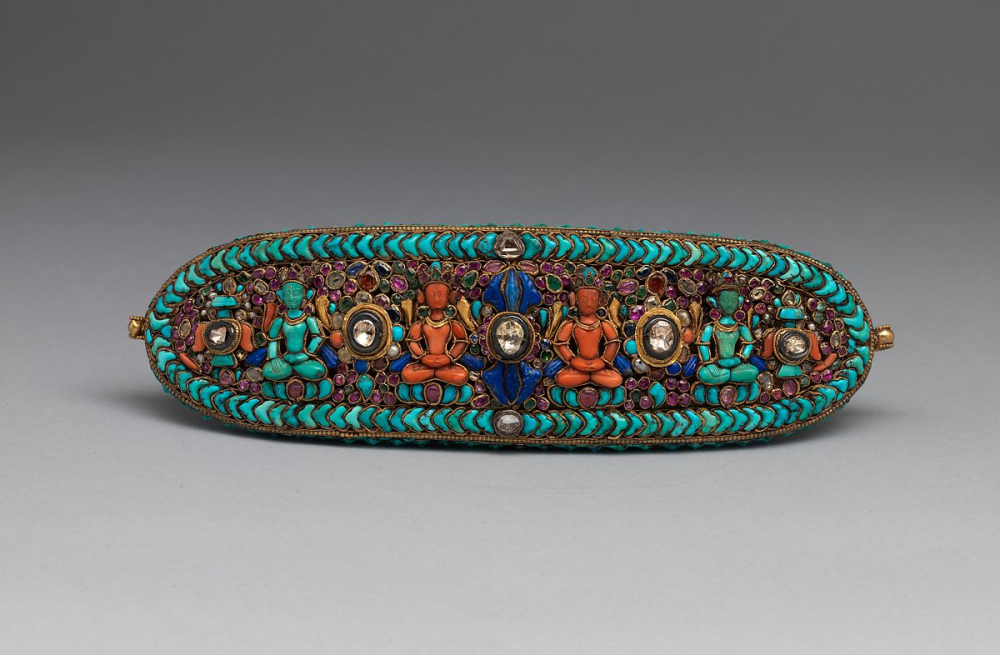
Ācāryaśākyamitra says: While the Buddha was practising in austere conditions at the bank of river Nairanjana, at that same time his wisdom body was teaching Yogatantra in the Akanishta realm (the highest level of heaven).
A person who understands his/her mind and tathagathagarbha or Buddhahood, s/he is able to understand this fact that the Buddha can perform many activities at a time. Buddhahood can’t be acquired from outside, it is achieved only through self-realisation. This can be understood when we analyse the synonyms of Vajrayana. It is said thus in Advayavajra:
Vajreṇaśūnyatāproktā, sattvenajňānamātratā/
tādātmyamanayoḥsiddhaṃvajrasattvasvabhāvataḥ// (p.24)
The inseparable nature of emptiness and wisdom is called vajra. And vajrayana is the method or path to visualise that very nature. It is said as follows in Guhyasamaja:
Kāyāvākcittavajreṇabhedyābheyasvabhāvatā // (18.36)
The body itself is speech. The speech itself is mind. The mind itself is body and speech. The oneness is the path to Vajrayana. It is also called resultant vehicle, or Phalayana, because the resultant body, activities, etc., are contemplated on the very path to it. From this, it is clear that tantra is an utmost secret, and it is not the subject of common people. Unless we understand the secrecy of tantra, we cannot do proper justice to the life and activities of Padmasambhava. It is like explaining four seasons to creatures who cannot survive even one season. So, how can it understand four seasons?
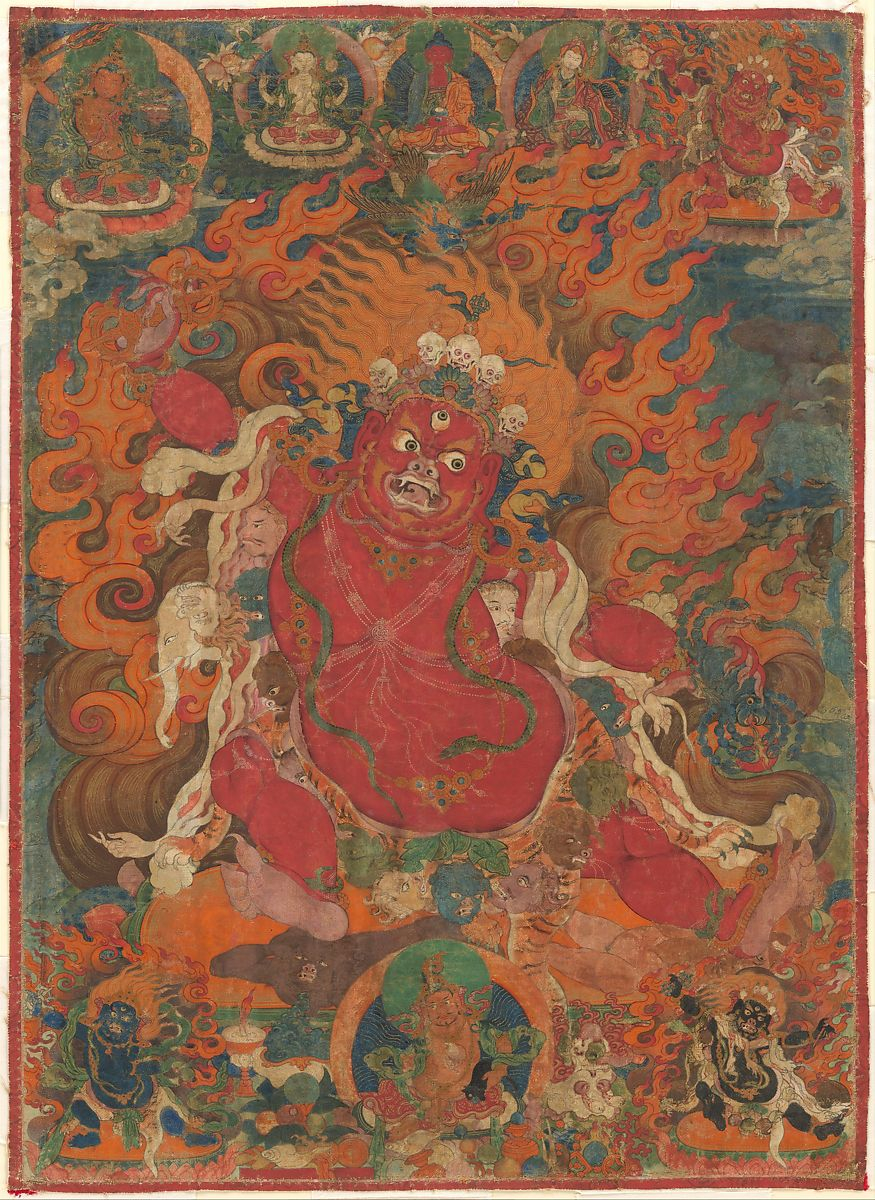
Mysterious elements are found from Theravada to Mantrayana. For example, it is said in the Atanatiya sutra that Shakyamuni Buddha goes to the thirty-third god realms and gives teaching to his mother. It is also said that the Buddha’s funeral did not catch fire until the Great Kashyapa reached Kusinagara. When he reached there, the Buddha revived and gave brief teachings on vinaya. Even in Paramitayana, Asanga goes to Tushita heaven and receives teachings from Maitreya, Tillipada goes to Akanishṭa heaven and receives Mahamudra teaching from Vajradhara, the great Tibetan translator Marpa meets the wisdom body of Nadapada after the passing away of Nadapada. Similarly, even though Acharya Candrakirti was born 600 years later, he meets with Nagarjuna. Nagarjuna’s wisdom blesses him and he composes Pradipodhyotana, commentary on Guhyasamaja. These mysterious events are not acceptable for the modern historians but the great acharya and accomplished teachers of both India and Tibet who devoted their whole life to spirituality accepted these mysterious facts unanimously. Therefore, we cannot deny the mysterious events with our limited intellect. For example, even in terms of the development of science, we know that from a balloon in the beginning, today the world has supersonic jets. Likewise, there are great powers of mind in terms of the secret practice of Vajrayana that we cannot deny. Likewise, the miraculous activities of Guru Rinpoche are so vast and profound.
Generally, four ways of taking birth are accepted in Buddhism, as it is said in the Abhidharmakosa:
caturdhānaratiryaňconārakāupapādukāḥ/
antarābhavadevāścapretāapijarāyujāḥ// (3.6)
There are all four types of births in human beings and animals. The commentary of the Abhidharmakosa can be consulted for detailed elaborations on it. Padmasambhava was born on the lotus flower.
As it is said in the Namasangiti:
buddhapadmodbhavaḥśrīmānsarvajňajňānakoṣadhṛk/
viśvamāyādarorājābuddhavidyādaromahān// (34-35)
It is said in sutra: ‘I achieve the mahaparinirvana to dispel the position of eternality. To dispel the position of the nihilism, I will take birth as a prince on the flower of the Dhanakosa pond.’ Thus the birth of Padmasambhava on the lotus flower and his beneficial activities are mentioned in sutras and tantras. The great Tibetan historian Pawo Tsuglak Trengwa has said: ‘To tame the non-human beings, Padmasambhava took the birth on the lotus and benefited innumerable beings.’ Therefore, the life and activities of Padmasambhava cannot be arranged in order.
Sakya Pandita also said thus in the Trisamvaravibhanga: ‘The king invited Padmasambhava to his country Tibet. He kept all the twelve earth-deities of Tibet in his custody. Therefore, the dissemination of non-Buddhist position is not possible here. Thus, all the great accomplished masters of Tibet bow down to him with respect.’
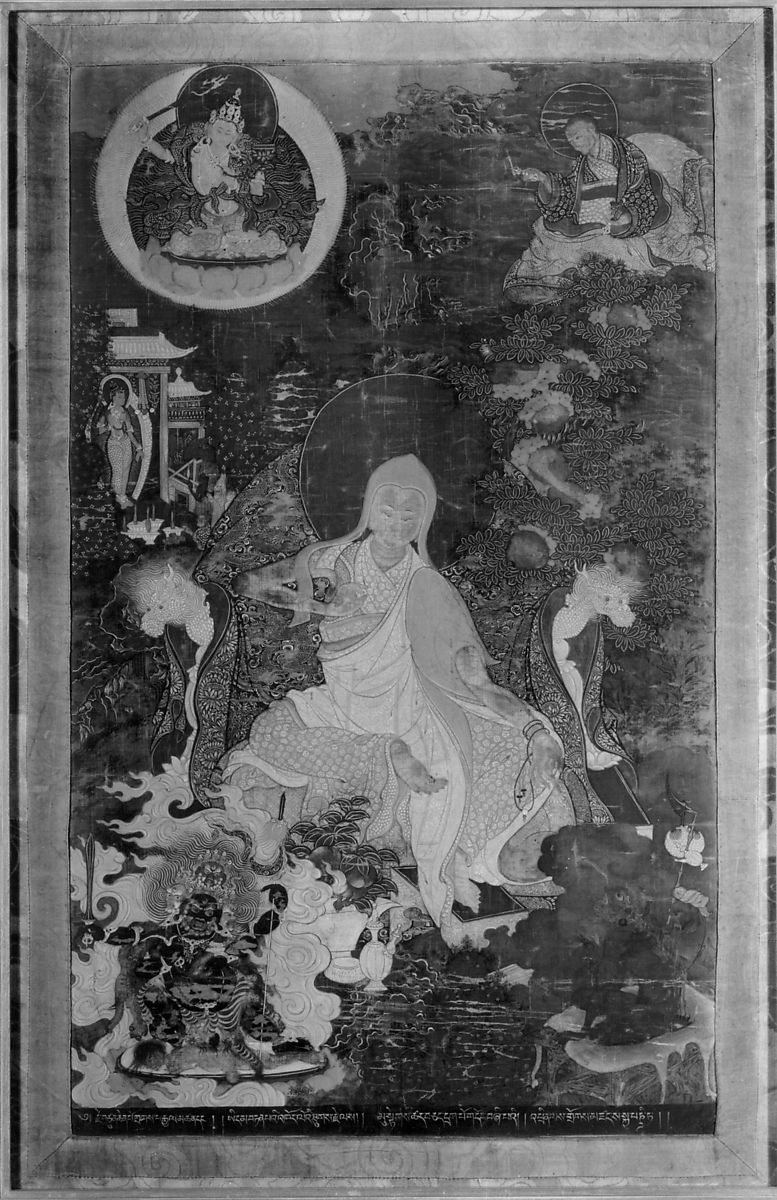
Describing Guru Rinpoche’s personality, Upadhyaya Santaraksita says: ‘I have put all the non-Buddhists in the Buddha’s teaching with my knowledge. I am well versed in all Sutras and Pāramitā texts and I practice Bodhicitta. But I cannot control the non-human beings of Tibet. To tame them, Guru Ācaryā Padmasambhava of Uḍdiyāna must be invited because he is the person who has achieved the accomplishment of longevity and the status of vidyadhara. He is able to control all gods, devils and restrict them to protect and disseminate dharma.’ Thus Upadhyaya Santaraksita requested Emperor Trisong Dechen. From this it is clear that Padmasambhava was an accomplished Tantric practitioner and had control over his life-span.
Dipankara Srijnana had a vision of the goddess Tara, and because of her inspiration, he became a monk rather than becoming a king. He was the chancellor of the Vikramashila Mahavihara (university) before he went to Tibet. He was a bodhisattva endowed with clairvoyance. He also said that Padmasambhava is equivalent to the second Vajradhara, and thanks to him, many scriptures were collected in the Samye monastery from dakas and dakinis, which were not available in India.
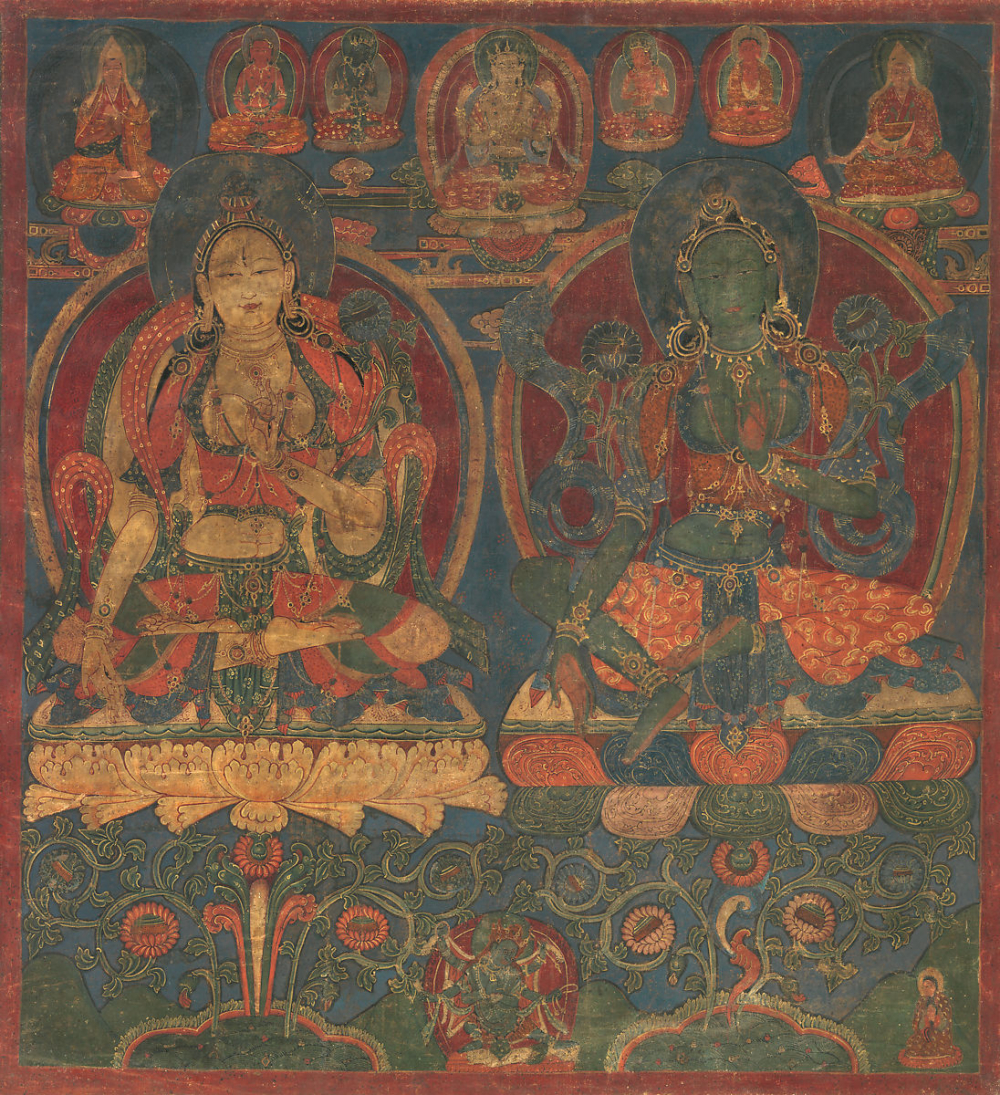
Today, Buddhism and its philosophy is spreading from our Himalayan regions to every corner of the world. And all credit goes to Padmasambhava. Regarding this, many prophecies and biographies are found in sutras, tantras and hidden teachings. If we simply understand the secrecy of mantra and his activity of being born on lotus, we don’t need to bother about anything else. It is like an unfathomable ocean from where we can take water as much as we need and use it. Guru Padmasambhava, though he was an enlightened person, received many teachings and initiation from great siddhas to inspire other human beings—Bhiksuni Anandi, Humkara, Buddhaguhya, Vimalayamitra, Rombu Guhyadeva, Srisimha, etc. Guru Padmasambhava has eight manifestations. These eight manifestations are named after the great marvellous activities of Guru Rimpoche.
1. His miraculous birth is manifested by Guru Tsokye Dorje.
2. While residing in Odiyana as a king, he was Guru Padma Gyalpo, also known as Gyalpo Throcog Chen.
3. His ordination and mastery on vinaya is manifested by Guru Sakya Senge.
4. He mastered all the teaching through the manifestation of Guru Loden Chogsed.
5. He subjugated all demonic spirits through the manifestation of Guru Nyima Oser.
6. He established Buddhism in Tibet through the manifestation of Guru Padma Sambhava.
7. Through the manifestation of Guru Senge Dadog, he defeated all non-Buddhist positions.
8. As Guru Dorje Dolod, he concealed many teachings for future generations.
These are the eight most important manifestations of Guru Rinpoche. Guru Rinpoche promised that, particularly on every tenth of waxing moon day, he would appear through the rays of the sun and perform activities for the benefit of sentient beings. So, if we are able to do special prayers on this day, the blessing will be more efficient.
Guru Rinpoche’s Disciples and Legacy
At the suggestion of Upadhyaya Santaraksita, the Tibetan king Trisong Deutsen invited Guru Rinpoche to Tibet; without his great power, it was not possible to control the demonic influences in Tibet. Guru Rinpoche controlled all demonic power and made them build the Samye monastery. Both Upadhyaya Santaraksita and Guru Rinpoche established Buddhism in Tibet, and they translated many texts into Tibetan. It is mentioned in Padma Kathang that many tantric texts were translated and preached by Guru Padmasambhava.
King Trisong Deutsen himself was the chief disciple of Guru Rinpoche and there were 25 other chief disciples of Guru Rinpoche. All were endowed with miraculous power and profound knowledge of Buddha’s teaching. They were: Namkhe Nyingpo, Nupchen Sangye Yeshe, Gyalwa Chokyang, Khandro Yeshe Tsogyal, Palgyi Yeshe, Langchen Palgyi Senge, Vairotsana, Nyak Jnanakumara, Gyalmo Yudra Nyingpo, Nanam Dorje Dudjom, Yeshe Yang, Sokpo Lhapal, Nanam Shyang Yeshe De, Kharchen Palgyi Wangchuk, Denma Tsemang, Kawa Paltsek, Shupu Palgyi Senge, Dre Gyalwe Lodro, Drokben Khye’u Chung Lotsawa, Otren Palgyi Wangchuk, Ma Rinchen Chok, Lhalung Palgyi Dorje, Langdro Könchok Jungne, Lasum Gyalwa Changchup, and Drenpa Namkha. Guru Rinpoche preached the highest tantric teaching to his very intelligent disciples.
When Guru Rinpoche was leaving Tibet, Khado Yeshe Tsogyal said: ‘Now whom shall we rely on? Who will be our refuge? Who will dispel the misery of the people of Tibet? Who will clear the knot of the teaching? Whom shall we share our spiritual experience? Please, favour us and do not abandon us.’ Guru Rinpoche replied: ‘I will not be separated from you. Meditate on me in your heart. I have concealed many teachings for the sake of future generation.’ Guru Rinpoche also kept his hand and foot imprints on many rocks, lakes, etc., for the people to seek blessings and inspiration. Thus, Guru Rinpoche kept many treasures for the future generation. These treasures are known as terma. Other great practitioners later revealed these teachings from time to time. There are 108 great masters who revealed the hidden teachings. Sange Lama was the first master to reveal the Guru’s teachings. The chief essences of treasure teachings are: Kagyed Desheg Duspa (eight sets of Tantric Teachings i.e. Yamantaka teaching, Mahamaya teaching, Heruka teaching, Kilaya teaching, etc.) and Dzongchen. Guru Rinpoche brought all tantric teachings, i.e. Mahayoga, Anuyoga, Atiyoga, into Tibet. Guru Rinpoche taught many heart essence teachings. There are also many Nyingthig teachings such as Khando Nyingthig and Vimala Nyingthig. Longchen Rabjam has explained Nyingthig teachings in his philosophical texts and practice manuals.
Guru Padmasambhava’s Place in Himalayan Regions:
Guru Rinpoche left vast and profound teachings for us to practice. Guru Rinpoche visited every corner of Tibet, Bhutan, Nepal, Himalayan regions of India and blessed the whole region. Therefore, we have many pilgrimage sites of Guru Rinpoche in Tibet and many of the Himalayan regions including Nepal, Bhutan, Pakistan, and Afghanistan. In fact, it is said that every dust of Tibet was blessed by Guru Rinpoche. Paro Taksang, the most famous pilgrimage site of Guru Rinpoche is located in Bhutan. In Nepal there are places such as Yang le Shod (Pharphing), Chu Migbyang Chub (Daman), Sala do lha (Muktinath), Maratika (Halesi), Timal, and so on, where Guru Rinpoche achieved some great siddhis and benefited many sentient beings. The Himalayan regions of India, like Sikkim, Ladhak, Himachal, Mon and Padma Kod, etc., all are also well known for pilgrimage sites related to Guru Rinpoche. In these places, imprints of Guru Rinpoche can be found everywhere. Guru Rinpoche’s influence can be seen in Himalayan people too. Everywhere tse-chu is performed in these regions and recitation of Guru Rinpoche’s mantra is very popular and regarded powerful by the people of these regions.
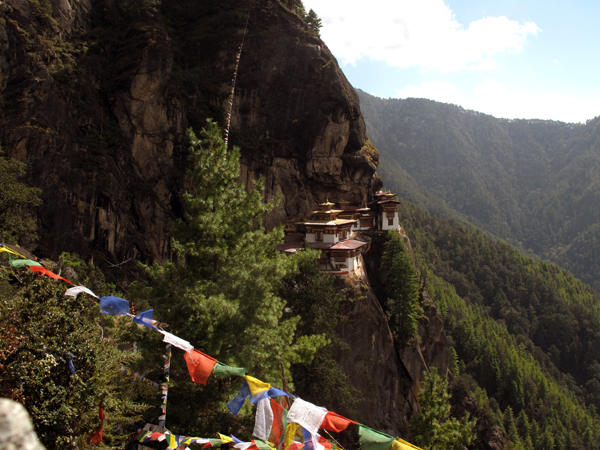
Next, let me throw some light on the ritual of Padmasambha. How can an ordinary person meditate while reciting the mantra of Padmasambhava? We will discuss it according to Pal Tashi Tomgyal’s teaching. One visualises in the following way:
Om āḥhūṃvajraguru Padmasiddhihūṃ
In the form of the rainbow-like body, on the seat of the sun and the moon, on one’s own head, the vidhyadhara, the mental manifestation of the Buddhas of all three times, Padmasambhava, on the white and red-coloured Vajra-seat, in the form of an eight-year-old boy, clad in the tantric cloth of blue colour, monk’s threefold cloth in red colour, and in king cloth, holding a Vajra on his right hand near the heart, holding a skull (full of elixir) on the left hand in meditation posture, wearing a lotus cap on his head, adorned with the various jewellery, very much attractive, resplendent, worthy of respect, gurus of the main tradition, deities, Dakinis, Dharma-protectors and Hidden-teaching protectors, all are surrounding (Padmasambhava).
One should meditate in this way. After that, one should invoke the knowledge deity.
Hūm, in the west-north direction of Uḍḍiyāna,
On the petal, the great wonderful renowned personality,
And surrounded by the retinue of ḍākas and ḍākinīs.
I do the rituals following you.
Therefore, come here to bless me.
Hūm, compiling the objects that are to be offered such as -
flowers, incense, lamps, divine food, fragrances, and so on,
With canopies, flags, musical instruments,
Valuable jewellery, flowers, forms,
Sounds, tastes, tactiles, mental objects,
The great essence Bodhicitta,
And with the inconceivable cloud of offering object,
I offer all these things to chief lineage masters,
Peaceful and wrathful deities,
Authoritative brave dharma-masters and ḍākinīs,
And all the dharma-protectors.
May they bestow me the success of body, speech and mind.
The syllable Om is the essence of the Buddha’s three bodies. The body is manifestation body, the speech is the enjoyment body and the mind is the truth body. The purpose of adding Om āḥhūṃ to the mantra of Guru Padmasambhava is that Guru Rinpoche is the representation of the body, speech and mind of all the Buddhas.
The meaning of Vajra—having obtained the correct knowledge of the reality of all phenomena which is of the non-conceptual nature and luminous, there will be the inseparable knowledge of all cause-conditional conventional truth. Padmasambhava is the inseparable form of the knowledge of the reality and the knowledge of convention. This is the meaning of Vajra. Another meaning of Vajra is that Padmasambhava’s body is similar to a diamond because it is the vajra wisdom body that has no suffering at all. His speech is like a diamond because it is true and irrefutable. His mind is free from both obscurations of afflictions and omniscience. Therefore, his mind is called diamond. Thus, Padmasambhava is of the nature of three diamonds. His body is adorned with thirty-two great marks and eighty sub-marks of a great man.
Guru generally is used in the sense of heavy. But here it is used with certain implications. In Tibetan, it is translated as “la-ma”. La means great. Guru (great) is the one who is endowed with all the good features in terms of wisdom and in terms of expedience, endowed with compassion, etc. According to the scriptures, the meaning of guru means to possess the self-prosperity (dharmakaya for one’s own purpose) and the other-prosperity (rupakaya and nirmanakaya for the purpose of others). Thus, one who possesses such three bodies is called a ‘guru’.
Padma is the symbol of activities. Just as the lotus born from mud is not smeared by it, similarly, Guru Padmasambhava, though they took the birth in the world, and he benefits the sentient beings and he himself remains untouched with the worldly defilement. In other ways, he is the manifested body of the Buddha Amitabha. In the five families, Buddha Amitabha is related to the lotus family. This is what Padma or lotus signifies. The Padma also signifies his activities. According to sutras, the Thus-gone One Buddha appeared in the disguise of a monk, performed twelve deeds and benefited the beings with his teachings. According to tantra, presenting three miracles, Padmasambhava took birth on a lotus flower. He became the prince of Uddiyana. He did austere dharma practice in the eight great cremation grounds, and being blessed with the knowledge of dakinis, he subdued the worldly dakas and dakinis, put them in the dispensation of the Buddha and he achieved the immortal Vidyadhara stage. With his tantric power, he defeated many non-Buddhists in Uddiyana, Zahor and Bodhgaya. He achieved Mahamudra in Yang Le Shod (Parphing), Nepal. He subdued many yakshas and yakshinis and entrusted them the responsibility to protect Buddhism. He obtained the illusory body and he benefited the world without being defiled by worldly defilements.
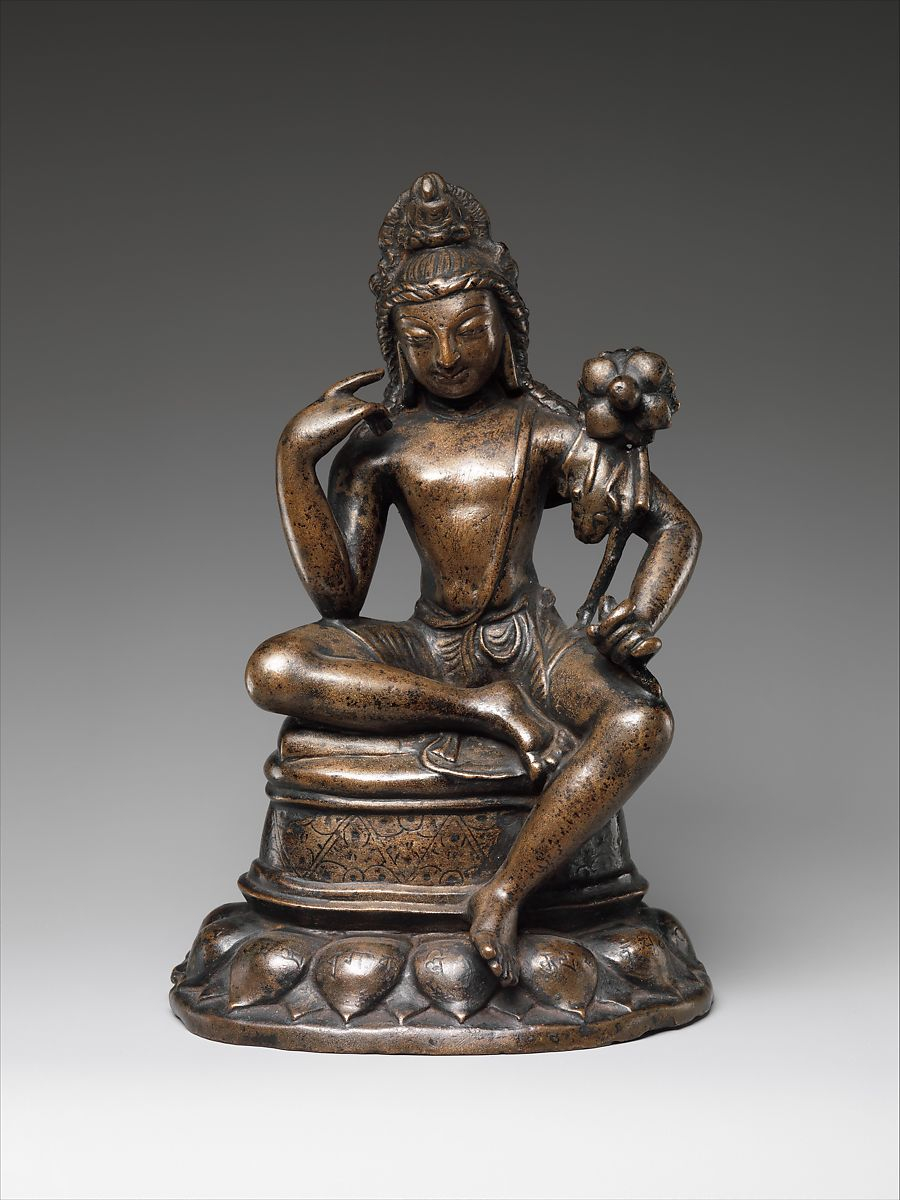
Siddhi is desired prayer. Siddhi is the achievement of well-cherished good qualities in our mind. There are two types of qualities—general and special. Seven qualities of heaven, eight common successes, an authority on four actions: pacification, prosperity, subjugation and wrathful actions are the general qualities. Seven qualities of heaven are longevity, cessation, beauty, luck, good clan, prosperity and knowledge. Eight common Siddhis are the ability to go quickly, medicinal tablet, disappearing, knowledge of the hidden treasure under the ground, mercury, sword and the ability to engage yakshas in work. The special quality is the achievement of omniscience or liberation. Thus, it is a prayer to Guru Padmasambhava who is able to bestow both the general and special siddhis and accomplishments.
Hūm is the mantra that inspires the mind. Hūm is the seed mantra. Thus, Hūm is known as the mantra that inspires and provokes the mind. It means ‘may Guru Padmasambhava bless me and may he consider me’.
Thus, this mantra means - May Guru Padmasambhava, the one who possess all those above-mentioned qualities and is able to bestow worldly and transcendental qualities upon sentient beings, give a boon to me. I pray to you. Considering me, benefit me.
Contemplating the above-mentioned practice, meditate that all the above-mentioned success is emitting in the form of rays from the visualised deity and is entering into our own body. Thus contemplated, finally, Guru Padmasambhava enters into one’s own body and one should stay attentively in Mahamudra Mahasampanna (Dzogchen).
There are two purposes to write this brief ritual. Firstly, from his mantra, it is proved that Guru Padmasambhava cannot be understood based merely on historical facts. We should be aware of Guru Padmasambhava’s mysterious biography as presented and visualised by the earlier masters of India and Tibet. Keeping all this in mind, we have to discuss the historicity of Padmasambhava, otherwise we will not be able to do justice to his personality.
Secondly, history is not important to general readers as they take interest in doing meditation with great devotion. Therefore, to benefit general readers, I have presented the viewpoint of the great masters of India and Tibet without considering various other points such as tales, history etc. described in many texts.
If there is no potentiality to become a Buddha in every individual, s/he will not become a Buddha. For example, one can obtain oil from a mustard seed but not from a grain of sand. Therefore, there is potentiality within everyone to become a Buddha. Its nature is of name and form which are the vital breath and mind. This is called Vajrasattva (Vajra-being) in Vajrayana. We have to understand this very well, otherwise our prayers to the desired gods/deities will not be successful. The nature of the name and the form of an individual is the vajrasattva from the time immemorial. It has neither beginning nor end. If there is beginning, its cause must be given, for which there will be the fallacy of its beginning and the fallacy of its eternality. It is natural that there is an end to which there is a beginning. Thus, it will be the fallacy of nihilism and there will be the fallacy that achieving Buddhahood is like extinguishing of a lamp. Achieving Buddhahood will be in vain in that condition. Therefore, it is said thus in Namasamgiti;
anādinidhanobuddhaādibuddhoniranvaya/
jňānaikacakṣuramalojňānamūrtistathāgataḥ//
If we are a part of a god, we too must have inherited godly knowledge or there must be a portion of the paramatman in this atman, because the qualities which is in the entirety, the same qualities must be there in its portion. Thus, the fact that everyone has the potentiality to become is substantiated. Therefore, the Buddhists accept that just as there is oil in a mustard seed, butter in milk, similarly, Buddha-nature exists in every sentient being. You can meditate upon your desired deity. You can invoke your desired deity and worship, and you can accomplish the welfare of both the self and other. Even today, the Thus-gone (tathaga) Buddha is with us in the form of dharma body.
